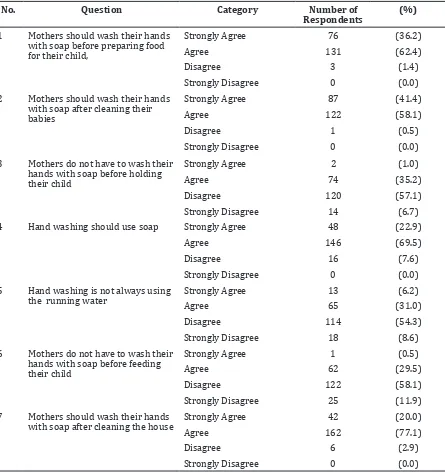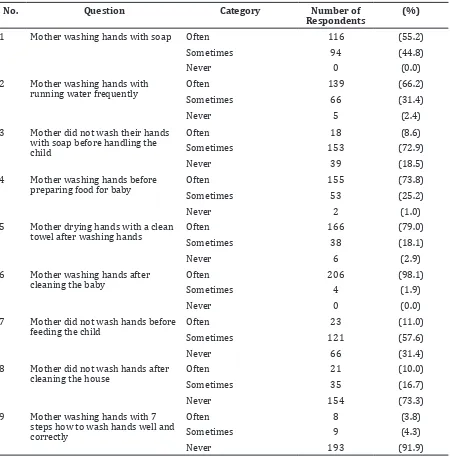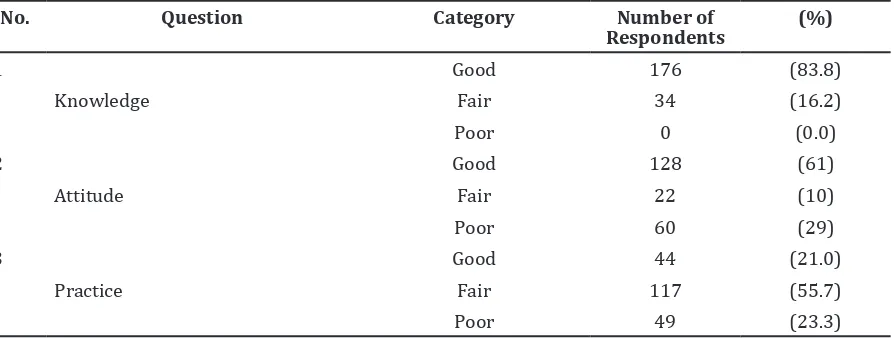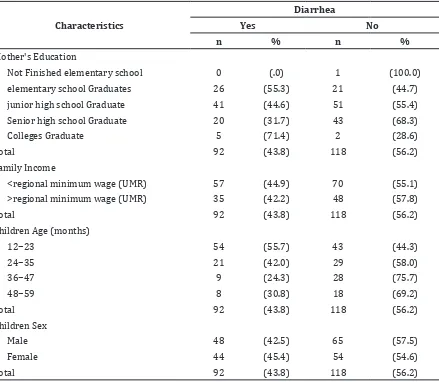Mothers’ Hand washing Practice and Diarrhea Cases in Children under
Five in Baleendah, Bandung
M. Syafril Firdaus,1 Insi Farisa Desy Arya,2 Dadang Hudaya Somasetia3
1Faculty of Medicine Universitas Padjadjaran, 2Department of Public Health Faculty of Medicine
Universitas Padjadjaran, 3Department of Child Health Faculty of Medicine, Universitas Padjadjaran/Dr. Hasan Sadikin General Hospital Bandung, Indonesia
Abstract
Background: Diarrhea is a disease, especially in children, with high mortality and morbidity rate in developing countries, including Indonesia. Diarrhea can be prevented if people can apply clean and healthy behaviors, especially hand washing. Hand washing is the cheapest, simplest, and the most effective methods for prevention of diarrhea. The objective of this study is to identify the knowledge, attitude, and practice of
mothers’ hand washing and diarrhea cases in children under five in Baleendah District, Bandung.
Methods: A descriptive study was conducted during September−November 2012 to 210 mothers who had children (ages 12−59 months) in Baleendah using rapid survey technique. The time allocated for each
village was adjusted to the population proportion for each region. The data were analyzed using computer
and was represented using frequency distribution.
Results: This study showed that the respondents had good level of knowledge and attitude of hand washing
(83.8% and 61%, respectively), but only 21% of the respondents’ practices of hand washing was in good
level. Most of the respondents did not wash their hands according to the 7 steps of correct hand washing.
Moreover the percentage of children with diarrhea in Baleendah was 43.8% (92 cases) during the study. Conclusions: There should be dissemination of information about the benefit of washing hands with 7
steps of correct hands washing so that families can practice it and can prevent diarrhea in children under
five. [AMJ.2015;2(1):191–8]
Keywords: Diarrhea, hand washing, practice, mother
Correspondence: M. yafril Firdaus, Faculty of Medicine, Universitas Padjadjaran, Jalan Raya Bandung-Sumedang Km.21,
Jatinangor, Sumedang, Indonesia, Phone: +6285695792727 Email: msyafrilfirdaus@yahoo.com
Introduction
Diarrhea is a major cause of children mortality and morbidity in the developing countries. Based on data from the World Health
Organization (WHO) in 2007, it was estimated that every year 100,000 Indonesian children
died from diarrhea. In addition, the data from Health Department of Republic of Indonesia in
2000 stated that 300 inhabitants from 1,000
people were affected by diarrhea each year.1,2 According to Indonesian Basic Health
Research 2007, the leading cause of death on
children in Indonesia are diarrhea and Upper Respiratory Infection.3Diarrhea infection is more dominant in babies because their endurance is still weak so they are highly susceptible to viral and bacterial infections that
cause diarrhea. According to United Nations International Children Fund (UNICEF) in 2012, it was estimated that each day 2,000 children under five worldwide died from diarrhea. In
developing countries, including Indonesia,
the baby suffering from diarrhea is more than 12 times per year, making the diarrhea as the
causes of death by 15−34% than other causes
of death. Babies who grow up in rural areas
are at risk of death 10 times greater than those
who grow up in urban areas.4
In West Java Province, the incidence of
diarrhea occurs up to 10%, surpassing the
national average of 9%. From West Java
Provincial Health Office report a few years
back, it was stated that Citarum Watershed was given a special attention due to the incidence of diarrhea, one region is Baleendah.5
Baleendah District is located in South
Bandung with an area of 985,149,5 ha width. Until now, the flood in Citarum River routinely
occurs every rainy season. Baleendah and its
surrounding areas are often flooded. Diarrhea
and respiratory problems often rise due to
floods in Baleendah.6 According to the Health
Center in 2010; diarrheal diseases became the top three diseases for children under five
In general, clean and healthy lifestyle behaviors in Indonesia are still lacking and it is not to be a community culture. The report from Baleendah Primary Health Care on clean
and healthy lifestyle behaviors in 2010, it was shown that from 1,050 households, only 508 that met the clean and healthy lifestyle
behaviors standard7. The clean and healthy lifestyle behaviors data also support the information that the diarrhea disease will continue occur every year when the public clean and healthy behavior does not change better.
According to WHO, hands are the main lines of germ entry into the body, as the hands often have direct contact with the mouth and nose. Hands can be exposed to germs when we come into contact with the body, others people, animals, or contaminated surfaces.1WHO shows that washing hands properly with soap
at 5 critical times can reduce the incidence of diarrhea by 40%. The five critical times are
before eating, after defecation and urination,
before holding the child, after cleaning the child, and before preparing food.8
Based on the above description, it can be recognized the important roles of mothers
who are closest to their children, the five significant times on washing hands with soap,
and the high incidence of diarrhea experienced
by children under five in Baleendah.Therefore,
the author is interested in studying the knowledge, attitude, and practice of mothers’ hand washing as well as the occurrence of
diarrhea cases in the children under five in
Baleendah, Bandung District.
Methods
A descriptive study was conducted during
September−November 2012 to 210 mothers who had children (ages 12−59 months) in Baleendah using rapid survey technique.9 The time allocated for each village was adjusted to the population proportion for each region.
Table 1 Questions About Respondents’ Hand washing Knowledge (n=210)
No. Question Category Number of
Respondents
(%)
1 Benefits of hand washing is to prevent a person affected by disease
Correct answer 201 (95.7)
Wrong answer 5 (2.4)
Do not know 4 (1.9)
2 Washing hands with soap is not only carried out when the hand looks dirty
Correct answer 62 (29.5) Wrong answer 148 (70.5)
Do not know 0 (0.0)
3 Hands are the main part of the body as media of germs enter the body
Correct answer 205 (97.6)
Wrong answer 1 (0.5)
Do not know 4 (1.9)
4 Hand washing should use running water
Correct answer 58 (27.6) Wrong answer 151 (71.9)
Do not know 1 (0.5)
5 There are 7 steps how to wash hands properly
Correct answer 37 (17.6)
Wrong answer 28 (13.3
Do not know 145 (69.0) 6 Washing hands with soap is one
of clean and healthy behavior in households
Correct answer 13 (6.2) Wrong answer 195 (92.9)
Do not know 2 (1.0)
7 Hand washing is a simple way to do, inexpensive and can prevent disease
Correct answer 201 (95.7)
Wrong answer 4 (1.9)
The results showed that Baleendah Village (49
respondents), Andir Village (28 respondents), Manggahang Village (28 respondents), Jelekong Village (21 respondents), Wargamekar Village
(14 respondents), BojongmalakaVillage
(21 respondents), Rancamanyar Village (35 respondets), and Malakasari Village (14 respondents).
The respondents had to meet the inclusion
criteria: the child’s mother was at home during the study and agreed to participate in filling in validated questionnaire about hand washing.
The questionnaire consisted of 5 questions
about characteristic of the respondents, 7
questions about knowledge and attitude respectively, and 9 questions about hand
washing practice. The data were analyzed using computer and was represented using
frequency distribution.
Results
Questions about hand washing knowledge
Table 2 Questions About Respondents’ Hand Washing Attitude (n=210)
No. Question Category Number of
Respondents
(%)
1 Mothers should wash their hands with soap before preparing food for their child,
Strongly Agree 76 (36.2)
Agree 131 (62.4)
Disagree 3 (1.4)
Strongly Disagree 0 (0.0) 2 Mothers should wash their hands
with soap after cleaning their babies
Strongly Agree 87 (41.4)
Agree 122 (58.1)
Disagree 1 (0.5)
Strongly Disagree 0 (0.0) 3 Mothers do not have to wash their
hands with soap before holding their child
Strongly Agree 2 (1.0)
Agree 74 (35.2)
Disagree 120 (57.1)
Strongly Disagree 14 (6.7) 4 Hand washing should use soap Strongly Agree 48 (22.9)
Agree 146 (69.5)
Disagree 16 (7.6)
Strongly Disagree 0 (0.0)
5 Hand washing is not always using the running water
Strongly Agree 13 (6.2)
Agree 65 (31.0)
Disagree 114 (54.3)
Strongly Disagree 18 (8.6) 6 Mothers do not have to wash their
hands with soap before feeding their child
Strongly Agree 1 (0.5)
Agree 62 (29.5)
Disagree 122 (58.1)
Strongly Disagree 25 (11.9) 7 Mothers should wash their hands
with soap after cleaning the house
Strongly Agree 42 (20.0)
Agree 162 (77.1)
Disagree 6 (2.9)
consist of the benefit, ways of using soap,
running water, washing hands properly, and preventing the disease. Most of the respondents
could answer the question about the benefit of hand washing (95.7%). Hands are the main
part of the body as media of germs to enter the
body (97.6%). Hand washing is a simple way
to do, inexpensive and can prevent disease
(95.7%). The majority of mothers (69%) did
not know about the 7 steps of how to wash
hands properly. The rest of the questions were answered wrong (Table 1).
For the question about respondents hand
washing attitude, most of the respondents
was agree about washing with soap before
preparing food for their child (62,4%), after cleaning their babies (58.1%), and after cleaning the house (77.1%). Therefore, the respondents were disagree with the question
about do not have to wash their hands with
soap before holding their child (57.1%), hand
washing is not always using the running water
(54.3%), do not have to wash their hands with soap before feeding their child (54.3%) (Table 2).
For the level of hand washing practices,
from 210 respondents, 193 mothers (91.9%)
said they never washed their hands by
Table 3 Questions About Respondents’ Hand washing Practices (n = 210)
No. Question Category Number of
Respondents
(%)
1 Mother washing hands with soap Often 116 (55.2)
Sometimes 94 (44.8)
Never 0 (0.0)
2 Mother washing hands with
running water frequently OftenSometimes 13966 (66.2)(31.4)
Never 5 (2.4)
3 Mother did not wash their hands with soap before handling the child
Often 18 (8.6)
Sometimes 153 (72.9)
Never 39 (18.5)
4 Mother washing hands before preparing food for baby
Often 155 (73.8)
Sometimes 53 (25.2)
Never 2 (1.0)
5 Mother drying hands with a clean towel after washing hands
Often 166 (79.0)
Sometimes 38 (18.1)
Never 6 (2.9)
6 Mother washing hands after cleaning the baby
Often 206 (98.1)
Sometimes 4 (1.9)
Never 0 (0.0)
7 Mother did not wash hands before feeding the child
Often 23 (11.0)
Sometimes 121 (57.6)
Never 66 (31.4)
8 Mother did not wash hands after cleaning the house
Often 21 (10.0)
Sometimes 35 (16.7)
Never 154 (73.3)
9 Mother washing hands with 7 steps how to wash hands well and correctly
Often 8 (3.8)
Sometimes 9 (4.3)
following the 7 steps of how to wash hands
properly (Table 3).
Knowledge, attitude, and practice are essential in any clean and healthy behaviors. Overall, a description about knowledge and attitude of the mothers regarding the importance of hand washing was in good
category (83.8% and 61%), meanwhile for the
description about respondent’s practice was
in fair level (55.7%) (Table 4).
According to sociodemographic characteristics and affordability, it can be
discovered that from 210 respondents, 92 of them had their children under five with diarrhea in the last month (Table 5). Based
on the age group of children, the incidence of diarrhea is mostly experienced in the age
group of 12−23 months, amounting to 58.7%, and at least in the age group of 48−59 months
by 8.7%.
Discussions
Based on the study result, a description on knowledge level of the mothers regarding the importance of hand washing is in good level. This evident is derived from the study showing that the average level of respondent knowledge
is in both categories (83.8%). However, the existing questionnaire questions, the question number 5 showed that the majority of mothers (69%) did not know about the 7 steps of
how to wash hands properly. This suggests that mothers understand the importance of washing hands with soap as one way of preventing the entry of germs into the body, but they do not know how to wash the hands properly. These results are similar to studies
in other villages, e.g. Hegarmanah and Sayang Villages, Jatinangor District, it was stated that 92.9% of women did not know about the 7 steps how to wash hands well and correctly.10
For the level of attitudes, the results of this study also showed that still there were mothers who had a relatively less stance on
the importance of hand washing (29%). A
study conducted in Hegarmanah and Sayang Villages, Jatinangor District, showed as much as 78.1% of women were categorized in good level.10 According to Bloom, the attitude factors
become the major influence on people’s health
status. Maternal attitudes in health is crucial to the health status of the families, including their children. This is because the mothers usually become the direct caregiver for the child so that more interaction occurs.11
For the level of hand washing practices, most mothers were in the category of enough
(55.7%). This indicates that most mothers
do not have good knowledge about hand washing practice. According to WHO report, people who do not have access to soap will
be difficult to implement washing hands with
soap.12 However, the absence of soap is not a barrier to washing hands with soap practice in this study. They have reason that the hand still looks clean. Therefore they assumed that washing hands was a very time consuming, moreover the lack of nearby places to wash hands, such as a sink, had become the reason for the low level of the respondents’ hand washing practices in this study. According to the study performed in Hegarmanah and Sayang Village, Jatinangor District, the study showed that as much as 82.4% of women were categorized in poor level.10
It is also worth to highlight the questionnaire
Table 4 Description about Respondents’ Hand washing Knowledge, Attitude, and Practice (n = 210)
No. Question Category Number of
results about 7 hand washing practices steps that were performed well and correctly. From
210 respondents, 193 mothers (91.9%) said
they never washed their hands by following the 7 steps of how to wash hands properly. It is caused by mothers’ lack of knowledge about good hand washing, given that the maternal ignorance about the 7 steps reaching 69%. These results are similar to studies in Karachi, Pakistan, which also stated that as many as 84% women never washed their hands with the 7 steps.13
Overall, the study in Indonesia showed that people know many germs on the hands. However, hand washing behavior has not
become a daily habit, especially in the five critical times to wash hands: before eating,
after defecation and urination, before holding the child, after cleaning the child, and before
preparing food. There were only about 0−34%
who washed hands at the critical times.14,15 The results are not much different from other studies on developing countries. According to The Global Public Private Partnership for Hand Washing, hand washing habits in India
reached 34%, Ghana 3%, Senegal 31%, Nigeria 10%, and Burkina Faso 13%.12
Knowledge about health is the basis for behavior change, yet there is possibility of someone not to necessarily act on the knowledge base owned.16 According to the research in 11 major countries on hand washing behavior, there are three factors
affecting the hand washing behavior: planned
activity, motivation to conduct, and health behavior habits.17
Based on the study result, the incidence of
children under five with diarrhea in the last month were 210 respondents and 92 (43.8%) mother had children under five with diarrhea
Table 5 Diarrhea Cases in Children Under Five in The Last Month According to Sociodemographic Characteristics and Affordability
Characteristics
Diarrhea
Yes No
n % n %
Mother's Education
Not Finished elementary school 0 (.0) 1 (100.0)
elementary school Graduates 26 (55.3) 21 (44.7) junior high school Graduate 41 (44.6) 51 (55.4) Senior high school Graduate 20 (31.7) 43 (68.3)
Colleges Graduate 5 (71.4) 2 (28.6)
Total 92 (43.8) 118 (56.2)
Family Income
<regional minimum wage (UMR) 57 (44.9) 70 (55.1)
>regional minimum wage (UMR) 35 (42.2) 48 (57.8)
Total 92 (43.8) 118 (56.2)
Children Age (months)
12−23 54 (55.7) 43 (44.3)
24−35 21 (42.0) 29 (58.0)
36−47 9 (24.3) 28 (75.7)
48−59 8 (30.8) 18 (69.2)
Total 92 (43.8) 118 (56.2)
Children Sex
Male 48 (42.5) 65 (57.5)
Female 44 (45.4) 54 (54.6)
in the last month. The other studies conducted
in the slums of North Jakarta with household survey technique showed that children under five with diarrhea in the last month reached
13% children.18These results is in contrast with Baleendah District although both areas
are flooded areas.
Based on the age group of children, the incidence of diarrhea is mostly experienced in
the age group of 12−23 months, amounting to 58.7%, and at least in the age group of 48−59
months by 8.7%. These results are consistent with the research in Semarang. The research showed that the incidence of diarrhea in
children under five in the age group <24 months was (58.68%), followed by age group 24−36 months with (24.65%) and the least in group aged of 37−60 months with (16.67%)16. Similar results were also shown by the study of Health Primary Center Tetehosi Foa, District
Gido, Niasa Regency, North Sumatra19, stating that the largest proportion of children under
five with diarrhea were in the age group of 1−3 years, which was equal to 46.8%. All cases of diarrhea in children under five in
Baleendah were acute diarrhea, the diarrhea that occurred with the duration of no more than 14 days.
As conclusion, there should be information
dissemination on the benefit of washing hands
with 7 steps of correct hands washing through a simulation. In addition, the collaboration between health primary center and integrated health cares in the local community should also be made to promote the clean and healthy lifestyle behaviors campaign in the household. Therefore, the families can practice the clean and healthy lifestyle behaviors to prevent
diarrhea in children under five, especially with
washing hands with soap.
References
1. World Health Organization. Diarrhoea: why children are still dying and what
could be done. Geneva: World Health Organization; 2009.
2. West Java Provincial Health Office. PHBS
di sekolah. 2006. [Cited 2012 April 16].
Available from: http://www.diskes.
jabarprov.go.id/index.php?mod=&idMenu
K=50&iMenuTab=52.
3. Indonesian Council for Health Research and Development. Riset kesehatan dasar
Provinsi Jawa Barat. Jakarta: Health Department of Indonesian Republic; 2008.
4. Health Department of Indonesian
Republic. Profil kesehatan Indonesia
tahun 2008. 2008. [Cited 2012 April 20]. Available from: http://www.depkes. go.id/downloads/publikasi/Profil%20 Kesehatan%20Indonesia%202008.pdf. 5. West Java Provincial Health Office. Laporan
hasil riset kesehatan dasar Provinsi Jawa
Barat tahun 2007. 2007. [Cited 2012 April 20]. Available from: http://www.diskes.
jabarprov.go.id/index.php?mod=pubDow nload&idMenuKiri=9&idKategori=7. 6. Imanuel NS. Baleendah, Bandung. 2012
[Cited 2012 April 25]. Available from at: http://id.wikipedia.org/wiki/Baleendah_
Bandung.
7. Bandung District Health Office. Buku laporan tahunan puskesmas Baleendah
2011. Bandung: Bandung District Health Office; 2012.
8. Health Department of Indonesian Republic. Panduan penyelenggaraan hari
cuci tangan pakai sabun sedunia (HCTPS). 2nd ed. Jakarta; 2009.[Cited 2012 April 25]. Available from: http://digilib-ampl. net/file/pdf/panduan_HCTPS_09.pdf.
9. Sabri L, Ariawan I, Hadi EN, Trihandini I, Prasetyo S. Aplikasi survei cepat. 2nd ed.
Depok: Fakultas Kedokteran Universitas
Indonesia dan Pusat Data Kesehatan
Departemen Kesehatan; 1996.
10. Ikhsanun KP. Gambaran pengetahuan,
sikap, dan perilaku ibu rumah tangga tentang cuci tangan di Desa Hegarmanah dan Desa Sayang Kecamatan Jatinangor
tahun 2011 [minor-thesis]. Bandung: Universitas Padjadjaran; 2012.
11. Notoatmodjo S. Konsep perilaku
kesehatan, promosi kesehatan teori dan
aplikasi. Jakarta: PT. Rineka Cipta; 2010.
12. Mach M. Fighting child mortality through
handwashing. 2012. [Cited 2012 December 5]; Available from: http://mirayafm.net/
index.php/special-reports/9932-fighting- child-mortality-through-provision-of-safe-water.
13. Sherwani SK, Bashir A, Ahmed H, Alam SI. Knowledge, attitude, and practices of washing hands among mothers in Karachi,
Pakistan. Fuuast J Biol. 2011;1(1):103−6.
14. Sutriyanto E. Pentingnya cuci tangan pakai
sabun. 2011. [Cited 2012 December 5]; Available at: http://www.tribunnews.
com/2011/10/14/pentingnya-cuci-tangan-pakai-sabun.
15. Team CCiSC. WHO guidelines on
guidelinehandhygiene_summary.pdf.
16. Sinthamurniwaty. Faktor-faktor risiko kejadian diare akut pada balita
[minor-thesis]. Semarang: Universitas Diponegoro; 2006.
17. Curtis VA, Danquah LO, AungerRV. Planned,
motivated and habitual hygiene behaviour: an eleven country review. Health Educ Res. 2009;24(4):655−73.
18. Simanjuntak CH. Diarrhoea episodes and treatment-seeking behaviour in a slum
area of North Jakarta, Indonesia. J Health Popul Nutr. 2004:8(2):83−92.
19. Mendrofa K. Karakteristik balita penderita diare yang berobat di Puskesmas Tetehosi




